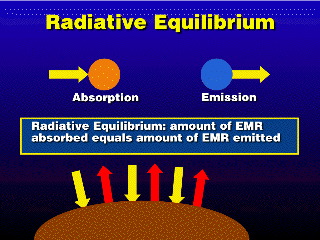 Radiative equilibrium is the balance that Nature tries to stay in.
If the amount of radiation received exceeds the amount emitted, then the object's
temperature increases, and vice versa. At equilibrium, the temperature is constant,
because the object is losing energy as fast as it is gaining it. This is just
like a steady-state box model, where the object
is the "box" and the stuff inside, energy, is measured by the temperature
instead of a concentration.
Radiative equilibrium is the balance that Nature tries to stay in.
If the amount of radiation received exceeds the amount emitted, then the object's
temperature increases, and vice versa. At equilibrium, the temperature is constant,
because the object is losing energy as fast as it is gaining it. This is just
like a steady-state box model, where the object
is the "box" and the stuff inside, energy, is measured by the temperature
instead of a concentration.
The Earth-atmosphere system is in
radiative equilibrium with space (incoming sunlight energy equals the amount
of energy emitted to space by the Earth-atmosphere system). Assuming everything
acts as a blackbody (meaning, the objects absorb all radiation falling on them),
we can compute the radiative temperature of Earth, and it turns out to be 255
K. This temperature is rather cold, equivalent to about 0°F or -18°C.
Note, though, that the Earth's surface
temperature averages 288 K, not 255 (the higher temperature, equivalent to 59°F,
is more comfortable than 0°F). The Earth's surface is still in radiative
equilibrium, since this value is not changing (other than natural variability
and the possibility of global change due to anthropogenic pollution). It turns
out that the surface is receiving (and emitting) more than just the sunlight
from the sun, so the temperature will be higher. This is due to the greenhouse
effect.


 Radiative equilibrium is the balance that Nature tries to stay in.
If the amount of radiation received exceeds the amount emitted, then the object's
temperature increases, and vice versa. At equilibrium, the temperature is constant,
because the object is losing energy as fast as it is gaining it. This is just
like a steady-state box model, where the object
is the "box" and the stuff inside, energy, is measured by the temperature
instead of a concentration.
Radiative equilibrium is the balance that Nature tries to stay in.
If the amount of radiation received exceeds the amount emitted, then the object's
temperature increases, and vice versa. At equilibrium, the temperature is constant,
because the object is losing energy as fast as it is gaining it. This is just
like a steady-state box model, where the object
is the "box" and the stuff inside, energy, is measured by the temperature
instead of a concentration.